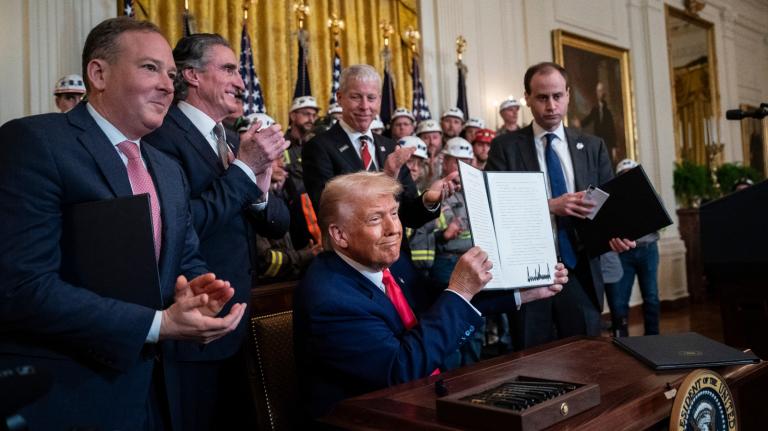Staying with the Monday Is Obama Day theme, here are a few thoughts on Obama’s energy plan. (Full plan here; speech introducing the plan here.)
Overall, I’m pleasantly surprised — even shocked — at its quality. It’s a deft mix of good politics and strong, substantive policy. Here are what I see as the three headlines:
- 100% auction of cap-and-trade credits. This is a home run, a real act of standard-setting boldness (the kind that Obama always promises but rarely delivers). The green community should immediately use it to push Clinton and Edwards into making the same commitment, insuring that it’s the new baseline for any cap-and-trade program.
- Smart investment. The revenue from auctions will be considerable, up to $50 billion a year, and Obama’s smart about putting it to work, dividing it between energy R&D, protections for low-income workers, and market deployment of existing clean tech.
- A focus on efficiency. Clearly Obama gets that efficiency is the easiest route to emission reductions, and he’s got a set of thoughtful, detailed initiatives to make it work.
More detailed thoughts below the fold.
Much has been said about Edwards’ important role in this campaign: pushing the other candidates toward stronger, more ambitious policy. You can see it at work here — in several respects Obama’s energy proposal echoes Edwards’.
However, with his promise to auction 100% of cap-and-trade credits, Obama has put himself out ahead of all the other frontrunners. He deserves the praise he’ll get for it.
As for investing the auction revenue, Obama gets it absolutely right:
Some of the revenue generated by auctioning allowances will be used to support the development and deployment of clean energy, invest in energy efficiency improvements and address transition costs, including helping American workers affected by this economic transition and helping lower-income Americans afford their energy bills by expanding the Low Income Home Energy Assistance Program, expanding weatherization grants for low-income individuals to make their homes more energy efficient, and establishing a dedicated fund to assist low-income Americans afford higher electricity and energy bills
Note that Obama is neatly transcending the faux-controversy between Shellenberger & Nordhaus and their critics: He’s putting regulation and investment on equal footing.
He’s smart on investment, too — some of it is for basic R&D, some of it for green jobs programs, and some for pushing existing technologies to market. I particularly like this:
The Clean Technologies Deployment Venture Capital Fund will be modeled on the highly-successful Central Intelligence Agency In-Q-Tel program. In-Q-Tel is a non-profit, independently-managed venture capital fund led by seasoned venture capital professionals to develop new intelligence technologies for the CIA. The first five years of In-Q-Tel funding led to 22 new technologies being used in 40 government programs.
The CTDVCF (which needs a better acronym) would be specifically designed to get technologies across the “valley of death” that separates the lab and the market. This is a creative way to spur rather than replace market incentives.
Naturally I’m not too excited about the ethanol business, but if you must have ethanol, this is about as good a balance as you could as for. It’s frank about the limitations of corn ethanol and promises plenty of research money for cellulosic. Most importantly, it specifically calls out the importance of local ownership of biofuel refineries, and promises some incentives that would encourage it.
Here’s the wording on dirty coal plants:
Obama will use whatever policy tools are necessary, including standards that ban new traditional coal facilities, to ensure that we move quickly to commercialize and deploy low carbon coal technology. Obama’s stringent cap on carbon will also make it uneconomic to site traditional coal facilities and discourage the use of existing inefficient coal facilities.
Sounds like he’s proposing more or less what Edwards is: requiring that new coal plants be IGCC. As I said in this post, that’s a big risk, and not anything close to as bold as requiring working CCS. Combined with the price on carbon, though, it certainly sends the right signal to coal companies: old-fashioned dirty coal is on the way out. Greens should push Clinton to go at least this far.
On efficiency, some highlights include making all new buildings carbon neutral by 2030, decoupling in the utility sector, and my personal favorite, investing in the smart grid.
The transportation stuff contains the usual promises to boost CAFE standards and mandate flex-fuel vehicles, but — praise be — it also contains several measures to reduce driving. Listen to this sweetness:
Barack Obama believes that we must move beyond our simple fixation of investing so many of our transportation dollars in serving drivers and that we must make more investments that make it easier for us to walk, bicycle and access other transportation alternatives.
There’s a limited amount the federal gov’t can do on this score, but Obama has been thoughtful about how to use those tools.
Finally, Obama says all the right things about the international effort — re-engage with the UN process, bring developing countries in, etc. etc.
There are certain areas where the plan is vague, and a few others where I’d disagree on details, but overall I think greens should be happy with its comprehensiveness and boldness. It’s just stunning how far the energy policy discussion has come in the last couple of years.


